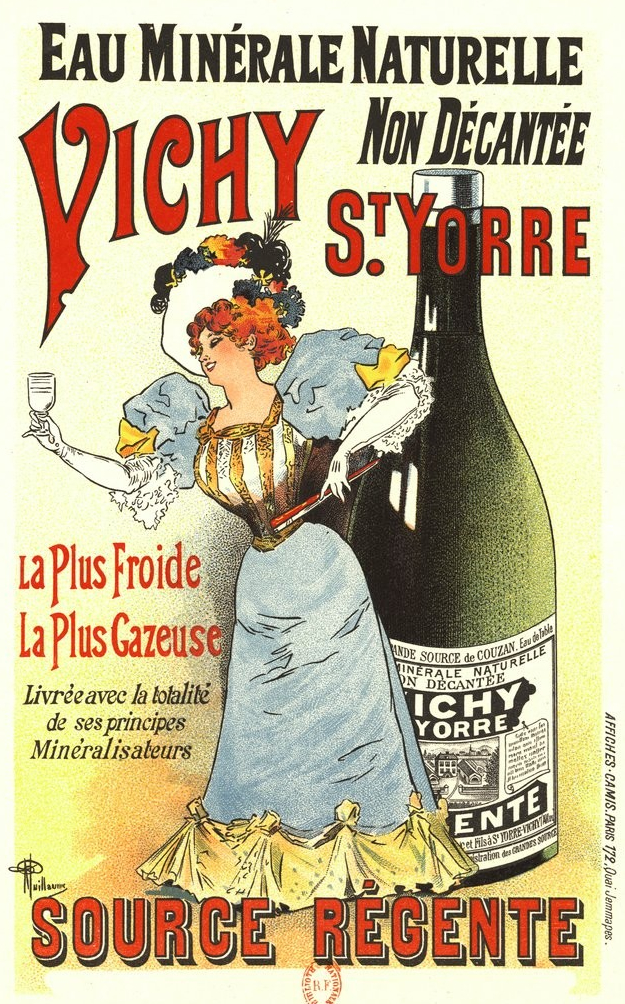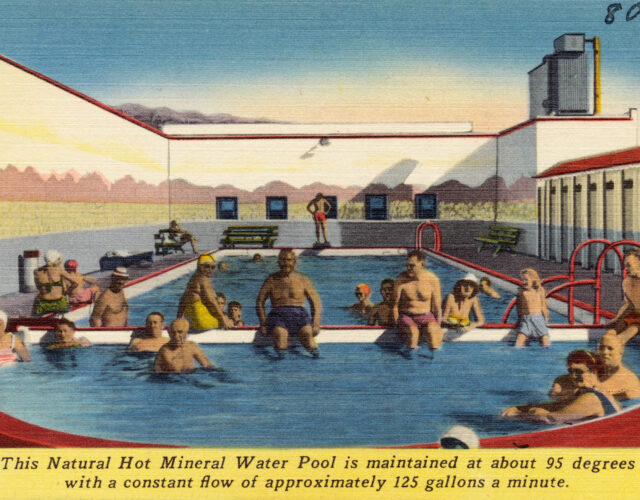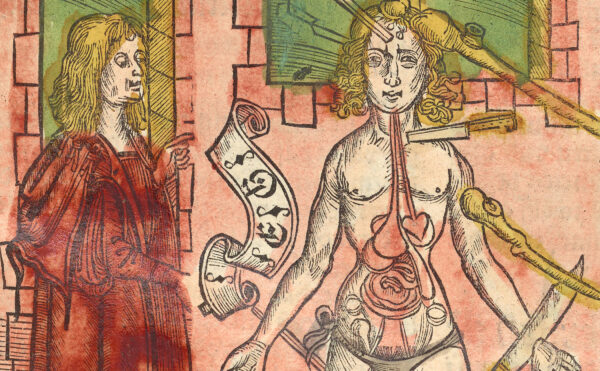Sparkling mineral waters of the 21st century are up-market drinks: Vichy, Evian, and Perrier persist as symbols of taste and class. More than just a drink, however, sparkling water represents one of the last vestiges of the therapeutic mineral springs that were a mainstay of Western medicine for more than two millennia. The story of their rise and fall is not only the hidden underpinning of the massive modern-day soft-drink industry but also the story of a growing alliance between chemistry and medicine that would reshape Western therapeutic practice.

In June 1772 the radical minister Joseph Priestley (1733–1804) described the details of a process that would eventually win him the Royal Society’s highest award, the Copley Medal. He had dripped a little oil of vitriol (sulfuric acid) on a mixture of chalk and water, caught the fixed air (carbon dioxide) that fizzed from the chalk in a bladder, and bubbled the fixed air through a column of water, which he then agitated at intervals. The resulting substance was, Priestley wrote, “an exceedingly pleasant sparkling water, resembling Seltzer water.”
Histories of the soft-drink industry often begin with this moment—one of the earliest simple methods of making what we now call carbonated water. Historians of chemistry also refer to it as a significant event in the development of pneumatic chemistry (the 17th- to 19th-century study of gases). Like many of his fellow chemists, Priestley was busily elaborating the recent discovery that air, previously considered a single element (one of only four), was composed of different elements. Soon after his work with mineral water he was credited with the discovery of what he referred to as “dephlogisticated air,” a substance that Antoine-Laurent Lavoisier would soon afterward famously dub “oxygen.”
But for Priestley, effervescent water was not merely a pleasant drink, nor was it merely a philosophical problem. Instead of creating a new substance, he was imitating an old one. In particular, he was attempting to re-create the naturally sparkling mineral water that emerged from the renowned “Vapor Cave” of Pyrmont near Hanover, Germany. (The seltzer water he refers to is not the modern bottled product, but the waters from the springs of Seltzer, Germany.) Moreover it was not the particular taste of Pyrmont water that Priestley sought, but its effect on the body. For Priestley, as for his contemporaries, water was a medicine.
Water as Medicine
For centuries Europeans tapped their remarkable and varied landscape of natural springs for mineral water. Hot springs like those at Vichy and Bath offered waters warmed by geothermal heat or contact with magma; others like those at Naples were remarkable for their aching coldness. Some were salty, others tasted (and smelled) like sulfur, alkali, or iron. Finally—and perhaps most mysteriously—some, like those from the cities of San Pellegrino, Seltzer, Pyrmont, and Vergèze (the source of Perrier), had the pleasant acidic taste produced by bubbles. Our word spa comes from the town of Spa, Belgium, whose “chalybeate,” or iron-bearing, waters were used medicinally for 400 years. Clues to the springs’ importance remain in the names of modern cities that were founded on springs: Carlsbad and Wiesbaden (Bad means “bath” in German), Baden-Baden, Tunbridge Wells, and of course Bath.
For centuries Europeans tapped their remarkable and varied landscape of natural springs for mineral water.
Records of hydrotherapy and balneology, the medical use of waters and baths, stretch back to classical antiquity. Greek and Roman Hippocratic physicians used sequences of hot and cold baths to balance and harmonize the humors of their patients. Pliny the Elder and Vitruvius listed springs with exceptional qualities for treating diseases of the sinews, joints, urinary tract, and skin. Ailing Romans drank from alkaline springs to rid themselves of tumors and from acidic springs to destroy gallstones. The elaborate ruins of Roman bath complexes in Baden, Switzerland, and Aquae Sulis in Great Britain (now the town of Bath) attest to the intensity of the Romans’ interest in hydrotherapy.
Although Hippocratic medicine temporarily declined during the Middle Ages, the use of mineral springs continued. “Holy wells,” first associated with pagan divinities and later reassigned to Christian saints, took the place of the Roman baths. The Renaissance revival of Greek medicine brought old springs back into prominence. Later, during the early modern period, the rise of so-called chymical medicine produced new justifications for old practices by encouraging the therapeutic prescription of minerals and metals.
By the 18th century springs had become places of fashionable resort, where genteel and aristocratic visitors met to dance, promenade, and “take the waters.” In Bath a seasonal crowd of tourists drank and soaked in what we now know to be a mildly radioactive soup of potassium, lead, iron, strontium, calcium, magnesium, bismuth, and sulfur. Indeed, English towns like Harrogate and Epsom existed solely to support their springs, and therapeutic drinking waters from Carlsbad (in what is now the Czech Republic), Eger (in Hungary), Seltzer, Spa, and Pyrmont were regularly shipped around Europe in bottles.
Manufactured Waters
Given the immense sums invested in and derived from mineral springs, it is no surprise that generations of chemists, including such well-known natural philosophers as Robert Boyle, Friedrich Hoffmann, and Stephen Hales, attempted to explain what made each spring unique. Moreover, when the earliest chemical analyses revealed familiar materials like iron, niter, vitriol, sea salt, and alum, it was certain that attempts to imitate or even outdo nature would soon follow.
Perhaps the most spectacular of these imitations was “the Duke’s Bagnio,” or “New Spaw.” This Turkish bath, established on London’s Long Acre by Samuel Haworth, the duke of York’s physician, featured artificial mineral waters that appeared to bubble from the ground. Soon after the opening of the Bagnio in 1685, Robert Boyle published an essay on “the imitation of Natural Medicinal Waters, by chymical and other wayes,” which he intended to “help the Physician to guess at the quality and quantity of other ingredients that impregnate the Natural Water proposed.” In 1698 the botanist Nehemiah Grew commercialized Epsom salts (magnesium sulfate) as a simple and lasting re-creation of the mineral waters at Epsom, then drunk as a purgative and famed for their efficacy against ulcers. To this day Epsom salts are used as a foot soak and drunk as a remedy for constipation.
By the early 18th century dozens of chemists and physicians were concocting (and patients were drinking) bottled artificial mineral waters made from smelter’s slag, potash, cream of tartar, quicklime, and alum. As the century progressed, manufacturers of artificial waters began to argue that their products had certain advantages over natural substances. Not only was artificial mineral water available outside the “seasons” of the spas, but it also could be kept free of the poisonous substances that sometimes plagued natural waters. They could also be made at higher concentrations, allowing patients to obtain the same benefits without requiring them to drink doses as large as 16 pints a day.
This host of imitations left physicians who practiced at mineral springs in a quandary. While they appreciated chemical analysis as a method of demonstrating the virtues of their springs, they were understandably nervous that analysis made replication possible. Previous theories, such as the idea that different mineral waters were “natural specifics,” medicines created by nature for man’s benefit as evidence of God’s beneficent design, seemed to offer support for claims of the superiority of natural mineral waters. This ambivalence resulted in public debates played out in pamphlets and medical journals: did mineral waters work because they contained valuable chemicals, what we might call “active ingredients”? Or were they only efficacious as complex wholes, emerging from natural sources, created by underground processes that humans could not hope to imitate?
Priestley and His Bubbled Water
One of the strongest arguments in favor of the use of natural mineral waters was their effervescence. Waters taken from the effervescent springs and kept too long lost their “mineral spirit”; that is, they went flat. Even when fresh, the first artificial waters did not possess this “spirit.” While not all natural springs possessed the bubbling properties that drew health seekers to Pyrmont, Vichy, and Seltzer, both the bubbles’ evanescence and the changed taste of flat waters suggested that waters irrevocably lost an important quality when imitated or taken far from their source.
It was precisely this issue that made Priestley’s work on mineral water so significant. In working to restore the mineral spirit, Priestley was able to build on the work of numerous predecessors. In the 1720s the cleric and physiologist Stephen Hales had developed the pneumatic trough, which Priestley would later use to manipulate pure gases, as a way of measuring the “airs” created by the physiological processes. In the 1750s chemist and physician Joseph Black identified the substance we now call carbon dioxide as “fixed air,” and in the 1760s physician William Brownrigg (1711–1800) argued that the mineral spirit of mineral waters was identical to the bubbles produced by fermentation and to the “choak-damp” that threatened miners.
One of the strongest arguments in favor of the use of natural mineral waters was their effervescence.
For Priestley, recent studies of fixed air suggested further therapeutic possibilities. Priestley’s recent candidacy for the post of ship’s naturalist on explorer James Cook’s second voyage had brought the British Navy’s crippling medical problem, scurvy, to Priestley’s attention. Since recent work on rotting meat by physician David MacBride (1726–1778) had seemed to suggest that fixed air arrested putrefaction, Priestley argued that drinking water impregnated with fixed air should not only cure scurvy, then thought to be a kind of rot, but also other diseases associated with putrefaction, including ulcerated lungs and cancers. Meeting with the approval of the British Navy, Priestley’s apparatus for bubbling fixed air through water were loaded onto Cook’s ships.
Three years after the publication of Priestley’s pamphlet entitled “Impregnating Water with Fixed Air,” British physician John Mervyn Nooth presented the Royal Society with the Nooth apparatus, a vertical arrangement of three glass vessels that aerated water in the central vessel by infusing it with fixed air from below. The Nooth apparatus became the model for the carbonation devices used in drugstores. The famous chemist Benjamin Silliman used Nooth’s device when he introduced commercially produced mineral waters to the United States, opening shops at first near his home at Yale University and later in New York and Philadelphia. In the 1780s another contact of Priestley’s, the Swiss jeweler and amateur scientist Jacob Schweppe, rapidly took over the London market with artificial sparkling mineral waters made using a force pump. The syphon—what we would now call a seltzer bottle—appeared in Great Britain in 1837.
A Second Wave of Mineral Waters
Like many of his competitors Schweppe added to the medicinal value of his tonics by mixing into them herbal syrups—one of which evolved into a drink immortalized as Schweppe’s Ginger Ale. Over the course of the 19th century consumers became accustomed to a series of medicinal flavors, from ginger and kola nut to the quinine that gave the gin-and-tonic its distinctive taste and protected British imperial administrators from malaria. These new products were billed both as beverages and as medicinals, under names such as “buffalo mead” and “imperial nerve tonic” that gradually lost their medicinal meaning. Coca-Cola, originally billed as a stimulant patent medicine (although its notorious cocaine content was negligible), is perhaps the most famous example of this transformation.
Mineral water bathing underwent a similar shift in meaning. Despite the competition offered by artificial mineral waters from the late 18th century onward, visits to spas and mineral springs remained an important part of therapy well into the 20th century, as evidenced by Franklin Delano Roosevelt’s well-publicized reliance on the waters of Warm Springs, Georgia. However, like the seaside vacation, which was originally designed to take advantage of the curative powers of sea air, spa visits increasingly became solely recreational rather than therapeutic.
Joseph Priestley’s Pyrmont water did not succeed as a cure for scurvy (although his colleague Brownrigg proved far more successful, with a carbonation device that mixed chalk with lime juice). But examining Priestley’s efforts both helps us find the roots of modern industry and outlines the shape of a complex medical past. In sipping a glass of ginger ale, seltzer water, or Perrier, we are participating in a centuries-old tradition of therapy.




